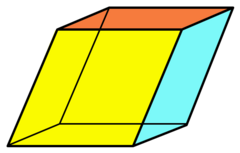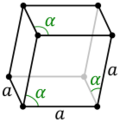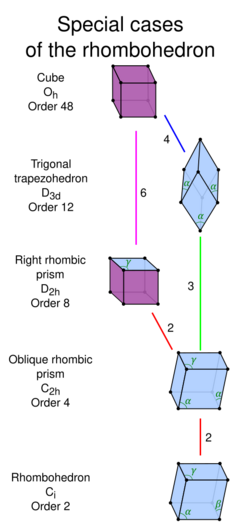Rhombohedron
| Rhombohedron | |
|---|---|

| |
| Type | prism |
| Faces | 6 rhombi |
| Edges | 12 |
| Vertices | 8 |
| Symmetry group | Ci , [2+,2+], (×), order 2 |
| Properties | convex, equilateral, zonohedron, parallelohedron |
In geometry, a rhombohedron (also called a rhombic hexahedron[1] or, inaccurately, a rhomboid) is a three-dimensional figure with six faces which are rhombi. It is a special case of a parallelepiped where all edges are the same length. It can be used to define the rhombohedral lattice system, a honeycomb with rhombohedral cells. A cube is a special case of a rhombohedron with all sides square.
In general a rhombohedron can have up to three types of rhombic faces in congruent opposite pairs, Ci symmetry, order 2.
Four points forming non-adjacent vertices of a rhombohedron necessarily form the four vertices of an orthocentric tetrahedron, and all orthocentric tetrahedra can be formed in this way.[2]
Rhombohedral lattice system
The rhombohedral lattice system has rhombohedral cells, with 6 congruent rhombic faces forming a trigonal trapezohedron:
Special cases by symmetry
| Form | Cube | Trigonal trapezohedron | Right rhombic prism | Oblique rhombic prism |
|---|---|---|---|---|
| Angle constraints |
[math]\displaystyle{ \alpha=\beta=\gamma=90^\circ }[/math] | [math]\displaystyle{ \alpha=\beta=\gamma }[/math] | [math]\displaystyle{ \alpha=\beta=90^\circ }[/math] | [math]\displaystyle{ \alpha=\beta }[/math] |
| Symmetry | Oh order 48 |
D3d order 12 |
D2h order 8 |
C2h order 4 |
| Faces | 6 squares | 6 congruent rhombi | 2 rhombi, 4 squares | 6 rhombi |
- Cube: with Oh symmetry, order 48. All faces are squares.
- Trigonal trapezohedron (also called isohedral rhombohedron):[3] with D3d symmetry, order 12. All non-obtuse internal angles of the faces are equal (all faces are congruent rhombi). This can be seen by stretching a cube on its body-diagonal axis. For example, a regular octahedron with two regular tetrahedra attached on opposite faces constructs a 60 degree trigonal trapezohedron.
- Right rhombic prism: with D2h symmetry, order 8. It is constructed by two rhombi and four squares. This can be seen by stretching a cube on its face-diagonal axis. For example, two right prisms with regular triangular bases attached together makes a 60 degree right rhombic prism.
- Oblique rhombic prism: with C2h symmetry, order 4. It has only one plane of symmetry, through four vertices, and six rhombic faces.
Solid geometry
For a unit (i.e.: with side length 1) isohedral rhombohedron,[3] with rhombic acute angle [math]\displaystyle{ \theta~ }[/math], with one vertex at the origin (0, 0, 0), and with one edge lying along the x-axis, the three generating vectors are
- e1 : [math]\displaystyle{ \biggl(1, 0, 0\biggr), }[/math]
- e2 : [math]\displaystyle{ \biggl(\cos\theta, \sin\theta, 0\biggr), }[/math]
- e3 : [math]\displaystyle{ \biggl(\cos\theta, {\cos\theta-\cos^2\theta\over \sin\theta}, {\sqrt{1-3\cos^2\theta+2\cos^3\theta} \over \sin\theta} \biggr). }[/math]
The other coordinates can be obtained from vector addition[4] of the 3 direction vectors: e1 + e2 , e1 + e3 , e2 + e3 , and e1 + e2 + e3 .
The volume [math]\displaystyle{ V }[/math] of an isohedral rhombohedron, in terms of its side length [math]\displaystyle{ a }[/math] and its rhombic acute angle [math]\displaystyle{ \theta~ }[/math], is a simplification of the volume of a parallelepiped, and is given by
- [math]\displaystyle{ V = a^3(1-\cos\theta)\sqrt{1+2\cos\theta} = a^3\sqrt{(1-\cos\theta)^2(1+2\cos\theta)} = a^3\sqrt{1-3\cos^2\theta+2\cos^3\theta}~. }[/math]
We can express the volume [math]\displaystyle{ V }[/math] another way :
- [math]\displaystyle{ V = 2\sqrt{3} ~ a^3 \sin^2\left(\frac{\theta}{2}\right) \sqrt{1-\frac{4}{3}\sin^2\left(\frac{\theta}{2}\right)}~. }[/math]
As the area of the (rhombic) base is given by [math]\displaystyle{ a^2\sin\theta~ }[/math], and as the height of a rhombohedron is given by its volume divided by the area of its base, the height [math]\displaystyle{ h }[/math] of an isohedral rhombohedron in terms of its side length [math]\displaystyle{ a }[/math] and its rhombic acute angle [math]\displaystyle{ \theta }[/math] is given by
- [math]\displaystyle{ h = a~{(1-\cos\theta)\sqrt{1+2\cos\theta} \over \sin\theta} = a~{\sqrt{1-3\cos^2\theta+2\cos^3\theta} \over \sin\theta}~. }[/math]
Note:
- [math]\displaystyle{ h = a~z }[/math]3 , where [math]\displaystyle{ z }[/math]3 is the third coordinate of e3 .
The body diagonal between the acute-angled vertices is the longest. By rotational symmetry about that diagonal, the other three body diagonals, between the three pairs of opposite obtuse-angled vertices, are all the same length.
See also
References
- ↑ "David Mitchell's Origami Heaven - Rhombic Polyhedra". http://www.origamiheaven.com/rhombicpolyhedra.htm.
- ↑ Court, N. A. (October 1934), "Notes on the orthocentric tetrahedron", American Mathematical Monthly 41 (8): 499–502, doi:10.2307/2300415.
- ↑ 3.0 3.1 Lines, L (1965). Solid geometry: with chapters on space-lattices, sphere-packs and crystals. Dover Publications.
- ↑ "Vector Addition". Wolfram. 17 May 2016. http://mathworld.wolfram.com/VectorAddition.html.
External links
- Weisstein, Eric W.. "Rhombohedron". http://mathworld.wolfram.com/Rhombohedron.html.
- Volume Calculator https://rechneronline.de/pi/rhombohedron.php
 |



